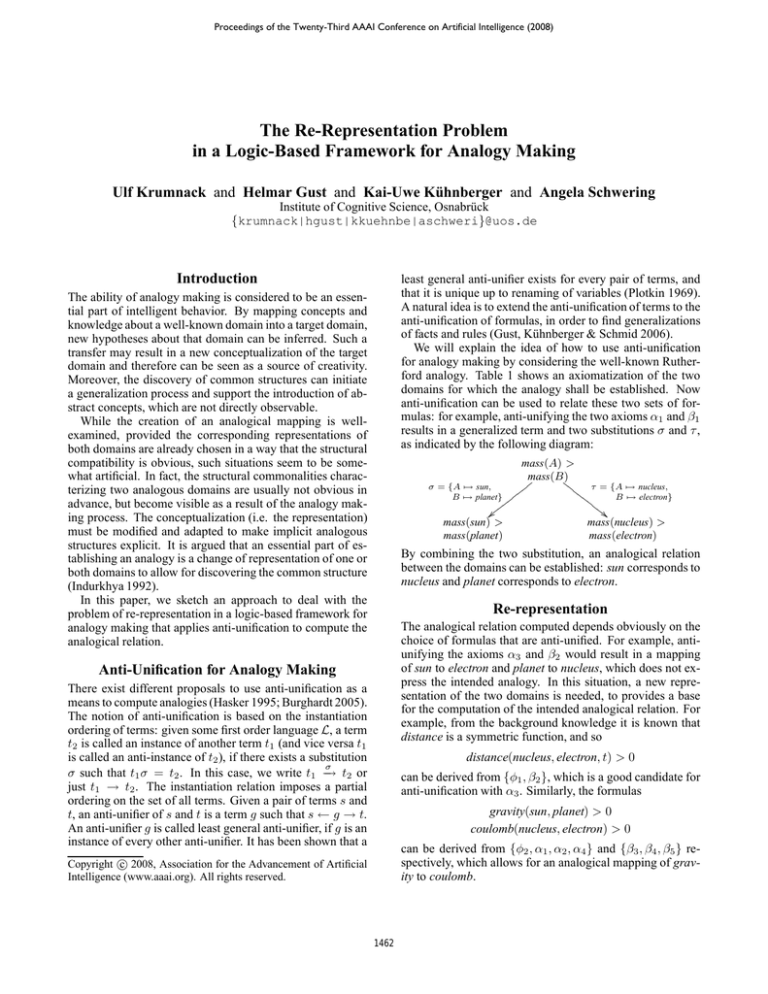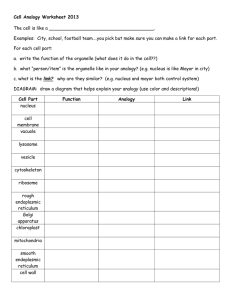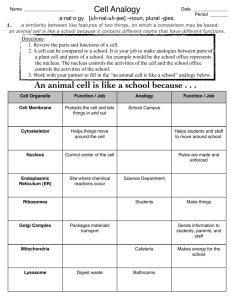
Proceedings of the Twenty-Third AAAI Conference on Artificial Intelligence (2008)
The Re-Representation Problem
in a Logic-Based Framework for Analogy Making
Ulf Krumnack and Helmar Gust and Kai-Uwe Kühnberger and Angela Schwering
Institute of Cognitive Science, Osnabrück
{krumnack|hgust|kkuehnbe|aschweri}@uos.de
Introduction
least general anti-unifier exists for every pair of terms, and
that it is unique up to renaming of variables (Plotkin 1969).
A natural idea is to extend the anti-unification of terms to the
anti-unification of formulas, in order to find generalizations
of facts and rules (Gust, Kühnberger & Schmid 2006).
We will explain the idea of how to use anti-unification
for analogy making by considering the well-known Rutherford analogy. Table 1 shows an axiomatization of the two
domains for which the analogy shall be established. Now
anti-unification can be used to relate these two sets of formulas: for example, anti-unifying the two axioms α1 and β1
results in a generalized term and two substitutions σ and τ ,
as indicated by the following diagram:
The ability of analogy making is considered to be an essential part of intelligent behavior. By mapping concepts and
knowledge about a well-known domain into a target domain,
new hypotheses about that domain can be inferred. Such a
transfer may result in a new conceptualization of the target
domain and therefore can be seen as a source of creativity.
Moreover, the discovery of common structures can initiate
a generalization process and support the introduction of abstract concepts, which are not directly observable.
While the creation of an analogical mapping is wellexamined, provided the corresponding representations of
both domains are already chosen in a way that the structural
compatibility is obvious, such situations seem to be somewhat artificial. In fact, the structural commonalities characterizing two analogous domains are usually not obvious in
advance, but become visible as a result of the analogy making process. The conceptualization (i.e. the representation)
must be modified and adapted to make implicit analogous
structures explicit. It is argued that an essential part of establishing an analogy is a change of representation of one or
both domains to allow for discovering the common structure
(Indurkhya 1992).
In this paper, we sketch an approach to deal with the
problem of re-representation in a logic-based framework for
analogy making that applies anti-unification to compute the
analogical relation.
mass(A) >
mass(B)F
x
xx
xx
x
x
|xx
σ = {A 7→ sun,
B 7→ planet}
mass(sun) >
mass(planet)
FF τ = {A 7→ nucleus,
FF
FF B 7→ electron}
FF
"
mass(nucleus) >
mass(electron)
By combining the two substitution, an analogical relation
between the domains can be established: sun corresponds to
nucleus and planet corresponds to electron.
Re-representation
The analogical relation computed depends obviously on the
choice of formulas that are anti-unified. For example, antiunifying the axioms α3 and β2 would result in a mapping
of sun to electron and planet to nucleus, which does not express the intended analogy. In this situation, a new representation of the two domains is needed, to provides a base
for the computation of the intended analogical relation. For
example, from the background knowledge it is known that
distance is a symmetric function, and so
Anti-Unification for Analogy Making
There exist different proposals to use anti-unification as a
means to compute analogies (Hasker 1995; Burghardt 2005).
The notion of anti-unification is based on the instantiation
ordering of terms: given some first order language L, a term
t2 is called an instance of another term t1 (and vice versa t1
is called an anti-instance of t2 ), if there exists a substitution
σ
σ such that t1 σ = t2 . In this case, we write t1 −
→ t2 or
just t1 → t2 . The instantiation relation imposes a partial
ordering on the set of all terms. Given a pair of terms s and
t, an anti-unifier of s and t is a term g such that s ← g → t.
An anti-unifier g is called least general anti-unifier, if g is an
instance of every other anti-unifier. It has been shown that a
distance(nucleus, electron, t) > 0
can be derived from {φ1 , β2 }, which is a good candidate for
anti-unification with α3 . Similarly, the formulas
gravity(sun, planet) > 0
coulomb(nucleus, electron) > 0
can be derived from {φ2 , α1 , α2 , α4 } and {β3 , β4 , β5 } respectively, which allows for an analogical mapping of gravity to coulomb.
c 2008, Association for the Advancement of Artificial
Copyright Intelligence (www.aaai.org). All rights reserved.
1462
Background Knowledge
φ1 : ∀x∀y∀t : distance(x, y, t) = distance(y, x, t)
φ2 : ∀x∀y : x > y ∧ y > z → x > z
Solar System
α1 : mass(sun) > mass(planet)
α2 : mass(planet) > 0
α3 : ∀t : distance(sun, planet, t) > 0
α4 : ∀x∀y : mass(x) > 0 ∧ mass(y) > 0
→ gravity(x, y) > 0
α5 : ∀x∀y : gravity(x, y) > 0
→ attracts(x, y)
..
.
Rutherford Atom
β1
β2
β3
β4
β5
:
:
:
:
:
β6 :
mass(nucleus) > mass(electron)
∀t : distance(electron, nucleus, t) > 0
charge(nucleus) > 0
charge(electron) < 0
∀x∀y : charge(x) > 0 ∧ charge(y) < 0
→ coulomb(x, y) > 0
∀x∀y : coulomb(x, y) > 0
→ attracts(x, y)
Table 1: A formalization of the Rutherford analogy (fragment)
In general, the task of re-representation consists of finding
pairs of formulas from the domain theories, that posses a
common structure and expose the analogical relation.1 Here
the choice of logic as a representation formalism exhibits its
power, since beside the formulas explicitly given, there are
also implicit formulas that can be inferred from that axioms.
This provides a notion of re-representation in a quite natural
way, where other approaches for analogy making have to
introduce special and sometimes quite artificial means.
anti-unifiers, since any more general anti-unifier only adds
complexity without extending the analogical relation.
Obviously, least general anti-unifiers for sets of formulas
always exist: the minimal example is the empty set ∅. But
this is probably not a set we are looking for, since it results
in the empty analogical relation. Therefore we introduce the
concept of coverage: Given an anti-unifier hG, σ, τ i for AxS
and AxT , the subset Th(Gσ) of Th(AxS ) is said to be covered
by G and for AxT accordingly. In general, a greater coverage
is preferable, since it provides more support for the analogy,
although there exist some caveats.
Anti-Unification of Theories
To allow for a formal treatment of these ideas, we will now
extend the notion of anti-unification to sets of formulas. For
a set of formulas F , we denote the theory of F , i.e. the
set of all formulas that can be inferred from F , by Th(F ).
We call a set of formulas F1 an anti-instance of a set F2 , if
there exists a substitution σ such that Th(F1 σ) ⊆ Th(F2 ).2
σ
Again we write F1 −
→ F2 or just F1 → F2 . If Th(F1 σ) =
Th(F2 ), F1 is called a full anti-instance of F2 and we write
σ
F1 ⇒ F2 or just F1 ⇒ F2 . Given two sets of formulas AxS
and AxT , we call a triple hG, σ, τ i, consisting of a finite set
of formulas G and substitutions σ and τ , an anti-unifier of
σ
τ
AxS and AxT , iff AxS ←
− G −
→ AxT . hG, σ, τ i is more
′
′ ′
′
specific than hG , σ , τ i, if G is a full anti-instance of G
in a way that is compatible with the domain substitutions as
indicated by:
Conclusion and Future Work
This paper presents an approach to analogy making that uses
anti-unification to compute an analogical relation between
two domains that are formalized in first order logic. It is
shown how logical inference provides a way to tackle the
problem of re-representation. Future work concerns a theoretical assessment of the trade-off between the maximization
of coverage and the minimization of substitution complexities as well as an algorithmic realization of the ideas proposed and a thorough practical evaluation.
Acknowledgement This work was supported by the German Research Foundation (DFG) through the project ”Modeling of predictive analogies by Heuristic-Driven Theory
Projection” (grant KU 1949/2-1).
G′
References
θ
σ′
τ′
G JJ
JJτ
tt
JJ
tt
t
J% ztt
σ
AxS
σ ◦ θ = σ′
τ ◦ θ = τ′
Burghardt, J. 2005. E-generalization using grammars. Artificial Intelligence Journal 165(1):1–35.
Gust, H.; Kühnberger, K.-U.; and Schmid, U. 2006.
Metaphors and heuristic-driven theory projection (HDTP).
Theoretical Computer Science 354(1):98–117.
Hasker, R. W. 1995. The replay of program derivations. Ph.D. Dissertation, University of Illinois at UrbanaChampaign, Champaign, IL, USA.
Indurkhya, B. 1992. Metaphor and cognition: an interactionist approach. Kluwer Academic Publishers.
Plotkin, G. D. 1969. A note on inductive generalization.
Machine Intelligence 5:153–163.
AxT
Using a more specific anti-unifier can help to prevent proliferation of variables in the generalization. Therefore, in
the context of analogy making, we will apply least general
1
While in the given example, re-representation is just needed
to enhance the support for the analogy, there are cases in which
no analogy can be computed at all, if the given representation for
domains is not altered.
2
We consider only admissible substitution, i.e. substitutions
that do not introduce variables into the scope of a quantifier.
1463




